The ghost crabs of the Georgia barrier islands – all belonging to the species Ocypode quadrata – are among my favorite tracemakers anywhere, any time. My ichnological admiration for them stems from the great variety of behaviors they record in the beach and dune sands of the islands, telling many fascinating tales of what they were doing while no one was watching. Thus I thought it only appropriate that a blog entry posted close to Halloween deserved a story about an animal that not only has the word “ghost” in its common name, but one that also leaves mystifying marks of its unseen behavior.
On the dawn of June 22, 2004 on Sapelo Island (Georgia), my wife Ruth and I were presented with one of the most intriguing of ghost-crab mysteries related to their vestiges. We were scanning the freshly scoured surfaces of Nannygoat Beach on the south end of the island; high tide only a few hours before had cleansed the beach of the previous day’s traces. The low-angle rays of early-morning sunlight were optimal for contrasting any newly made animal signs on the beach, which is why we were there then. We went to the beach with our minds open to anything novel; indeed, my experience with the Georgia barrier islands is that no matter how many times you visit them, they always hold previously unsolved puzzles.
Sure enough, within about 15 minutes of stepping foot on the beach, Ruth paused and asked one of the most simple – yet important – of scientific questions: “What is this?” She pointed to a depression on the sandy surface, and what I saw was astonishing. It was a trace perfectly outlining the lower (ventral) half of a ghost crab, preserving in detail: impressions of all eight walking legs (pereiopods), including their pointed ends (dactyli); its smaller claw (inferior cheliped) and larger claw (superior cheliped); and its main, rectangular body.
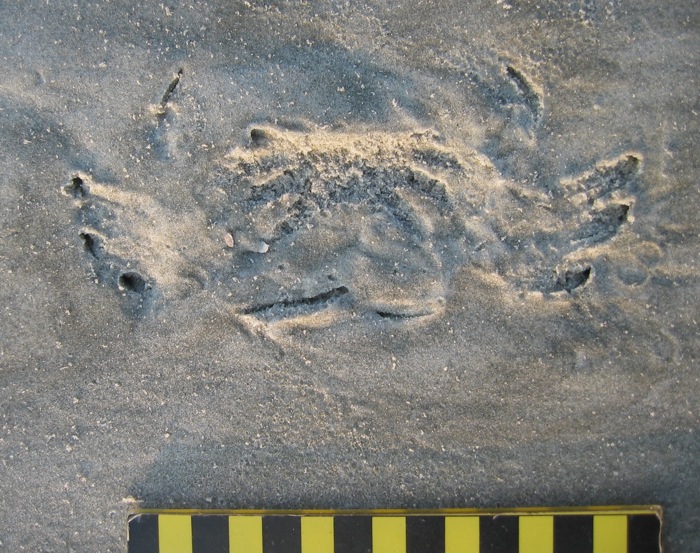 A perfect outline of the bottom side of a ghost crab (Ocypode quadrata), found just after dawn and high tide on Nannygoat Beach, Sapelo Island, Georgia. Why would a ghost crab make such a trace? (Scale in centimeters, and photograph taken by Anthony Martin.)
A perfect outline of the bottom side of a ghost crab (Ocypode quadrata), found just after dawn and high tide on Nannygoat Beach, Sapelo Island, Georgia. Why would a ghost crab make such a trace? (Scale in centimeters, and photograph taken by Anthony Martin.)
Even more strangely, only one set of tracks connected with this body imprint, leading away from it, and none moved toward it. This was not an impression made by the dead body of a crab. Instead, the tracks showed that the crab was very much alive when it made its resting trace and immediately afterwards. But what happened just before then? It looked as if the crab floated through the air, dropped vertically, made a perfect 10-point landing, sat there for a while, and walked away.
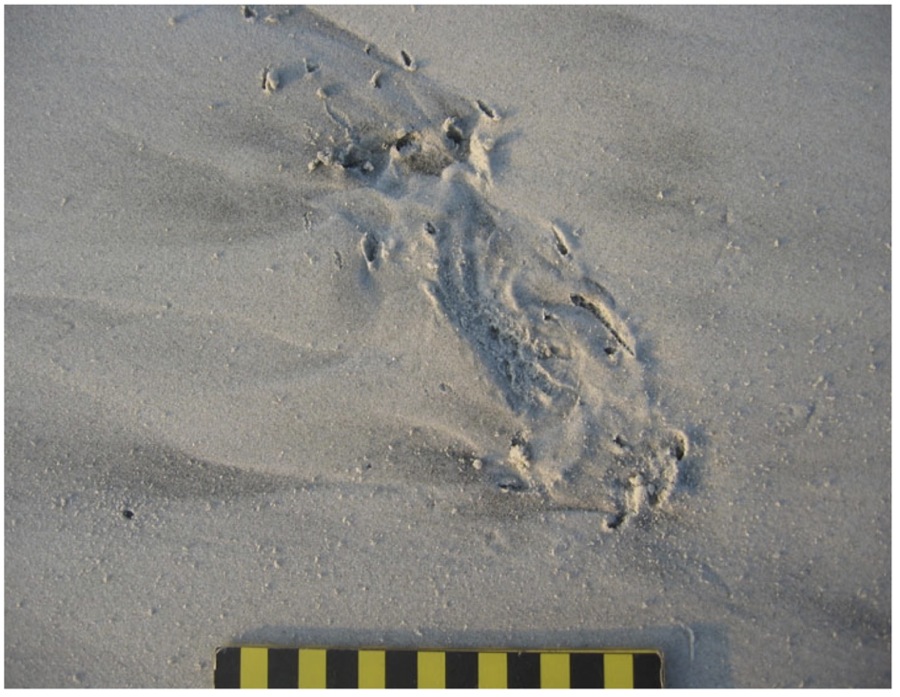 Another exquisitely defined ghost-crab body impression, and with tracks leading away from it, showing this is not a crab “death mask,” but one made by a live crab. (Scale in centimeters, and photograph taken by Anthony Martin.)
Another exquisitely defined ghost-crab body impression, and with tracks leading away from it, showing this is not a crab “death mask,” but one made by a live crab. (Scale in centimeters, and photograph taken by Anthony Martin.)
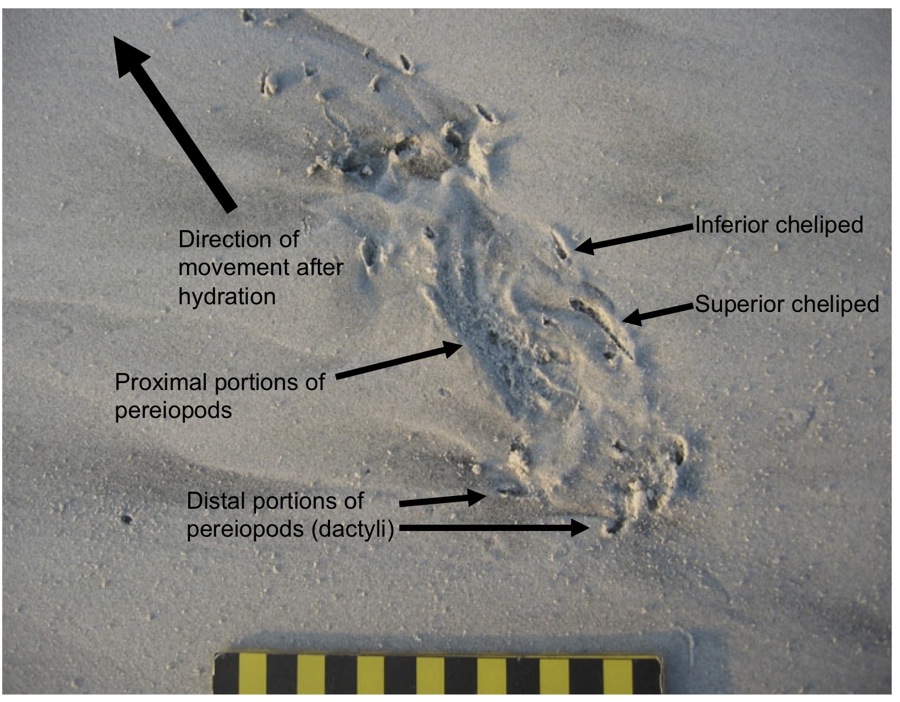 The same ghost-crab impression as above, but this time with the crab anatomy labeled and direction of movement after it stopped and sat down on the sand. What happened to the tracks that must have led to its resting spot? And what’s with that word “hydration”? Let’s just say this is what you call “foreshadowing” in the story. (Scale in centimeters, and photograph taken by Anthony Martin.)
The same ghost-crab impression as above, but this time with the crab anatomy labeled and direction of movement after it stopped and sat down on the sand. What happened to the tracks that must have led to its resting spot? And what’s with that word “hydration”? Let’s just say this is what you call “foreshadowing” in the story. (Scale in centimeters, and photograph taken by Anthony Martin.)
Knowing that ghost crabs can do a lot of things, but not aerial acrobatics, we wondered how this could have happened. Well, single observations can be the start of good science, but for this inquiry to progress any further, we had to see if this seemingly unusual observation could be repeated. So we walked further south along the beach to test whether this was an isolated incident, or if we could find any other ghost-crab outlines with single trackways attached. With such a search image in mind, we quickly found about a dozen more such marks made by crabs of various sizes, but showing an identical behavior. Even better, all were located just below the high-tide mark of the previous night.
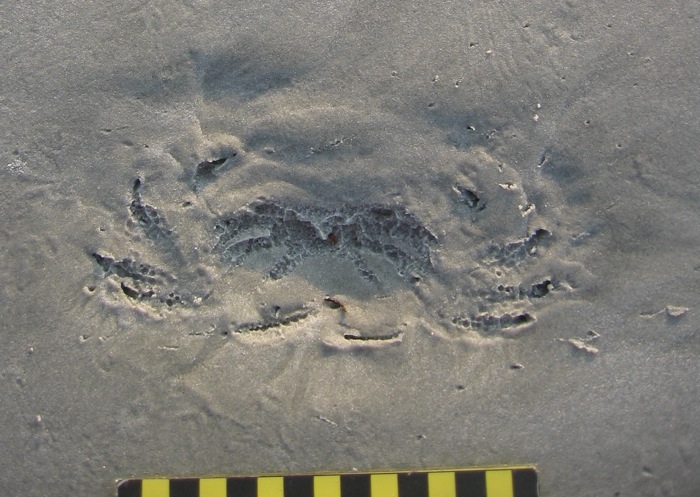 Yet another beautiful ghost-crab resting trace, surrounded by a scoured beach surface. Lot of these traces and all just below the high-tide mark meant something was happening that could be answered by the awesome power of science. (Scale in centimeters, and photograph taken by Anthony Martin.)
Yet another beautiful ghost-crab resting trace, surrounded by a scoured beach surface. Lot of these traces and all just below the high-tide mark meant something was happening that could be answered by the awesome power of science. (Scale in centimeters, and photograph taken by Anthony Martin.)
Time to think. These crabs must have walked to their resting places, but why didn’t they leave any tracks? We soon realized that the tracks were certainly made, but not preserved. So like all other surface traces on the beach, they must have been made erased during high tide. Yes, that was it! The crabs walked to the surf zone just after the high tide, sat down, waited long enough for the tide to drop a little bit, and walked away.
Mystery solved? Well, not quite. This was an incomplete explanation, one with a big, unanswered question. Why did the ghost crab walk to – and sit down in – the surf? (With a prompt like that, feel free to create your own intertidal-crab equivalent of “chicken-crossing-road” punch lines.) Ghost crabs normally spend much of their time in deep, J- or Y-shaped burrows close to or in the dunes, and above the high-tide mark. They are most active at night, when they come out of their burrows to scavenge delectable dead things dumped on the beach by waves and tides, or to prey on smaller invertebrates, like dwarf surf clams (Mulinia lateralis). They also leave their burrows to seek mates, which might involve one crab enticing another to check out its burrow.
 A seemingly indignant and defiant ghost crab outside of its burrow during the day, either looking for new territory, food, mates, or all three. They’re greedy that way. In this instance, though, it was mostly running away from me and my camera. (Photograph taken by Anthony Martin.)
A seemingly indignant and defiant ghost crab outside of its burrow during the day, either looking for new territory, food, mates, or all three. They’re greedy that way. In this instance, though, it was mostly running away from me and my camera. (Photograph taken by Anthony Martin.)
None of the crabs that made these traces were scavenging, preying, or mating, yet something in the surf was life-sustaining enough for them to risk becoming meals for early-morning predatory shorebirds. I searched my memory for what I had read previously about ghost crabs and their biological needs, and finally realized what could have driven them to the surf in the middle of the night: they were thirsty.
You see, ghost crabs are living examples of so-called “transitional animals” that evolution-deniers insist do not exist, having an interesting mixture of adaptations to different environments. These crabs are descended from fully marine crabs, so they still have gills that allow them to filter oxygen from marine water. Yet they also have little lungs and can breathe air, enabling them to stay out of the water for hours. Having both gills and lungs makes them semi-terrestrial, living in a world between the land and ocean, and dependent on both realms. They live close to the sea for their food, reproduction (females lay their fertilized eggs in sea water), and water, but their main livelihood is gained from the beach and dunes.
In this respect, ghost-crab burrows in the upper parts of beaches and lower parts of dunes provide protection against predators, but also keep the crabs hydrated. One of the functions of a ghost-crab burrow – which can be more than one meter (3.3 feet) deep, is to intersect the water table below. That way, when a crab needs water for proper respiration, it crawls down the burrow to that saturated area and replenishes it bodily fluids. But they can’t stay down there as the tide rises, so they move higher up the burrow to where there’s some air. Unlike blue crabs (Callinectes sapidus), which have completely developed gills and hence fully marine, if you keep a ghost crab in sea water too long, it drowns.
The previous night was a higher tide than normal, which probably flooded many of the ghost-crab burrows and causing these crabs to abandon their homes. This meant the crabs spent most of the night outside of their burrows, resulting in dehydration, but having to wait out the high tide. As soon as the tide turned and began to drop, the crabs ran to the surf zone, settled down into the wet sand, and soaked up water through small openings where the legs connect to the main body. Spiky “hairs” (setae) on their legs help with this water up-take, drawing up moisture from the sand through capillary action.
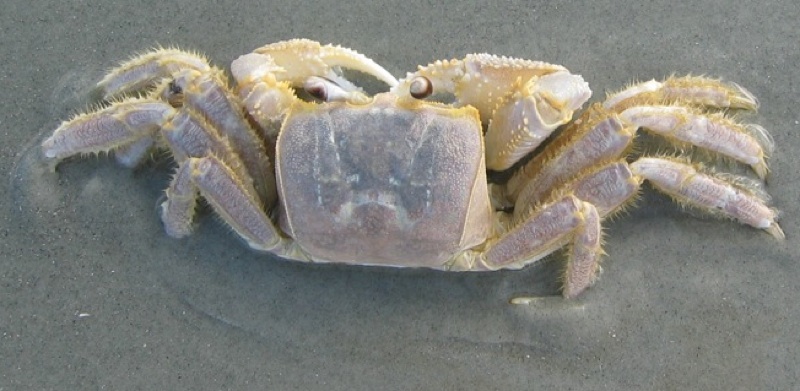 My legs? Sorry, I meant to shave. Guess you’ll have to deal with it. Hey, wait a minute: does that pose look like it could make anything you’ve already seen, like, oh, I don’t know, a resting trace? Keep reading. (Photograph by Anthony Martin.)
My legs? Sorry, I meant to shave. Guess you’ll have to deal with it. Hey, wait a minute: does that pose look like it could make anything you’ve already seen, like, oh, I don’t know, a resting trace? Keep reading. (Photograph by Anthony Martin.)
Ghost crabs are amazingly efficient at pulling water out of sand. So their hunkering down onto a saturated sandy surface with waves breaking on top of them must have been like the ghost-crab equivalent of drinking from a funnel, quenching their thirst in a most satisfying way. Meanwhile, waves washed away their tracks leading to these resting spots. They stayed a while, long enough for the tide to drop and expose the sandy beach surface. Only then did they get up and walk away, fully rehydrated, refreshed, and ready to go back to their burrows or dig new ones.
This was a detailed explanation, but one based entirely on traces and what little I knew about ghost crabs from the scientific literature. How else to test it and see whether it was right or not?
If you just said, “By directly observing this interpreted behavior in a ghost crab,” you would be right. A little more than a month later, on July 30, 2004, I actually got to witness this behavior, and on Nannygoat Beach. Back without Ruth this time, and by myself, I was looking for more traces following a high tide, when I saw a small, wraith-like movement out of the corner of my eye. It was a beautiful adult ghost crab, flat-out running in full daylight and heading straight from the dunes to the surf zone. I stood back and watched it reach the surf, where it promptly sat down and became still.
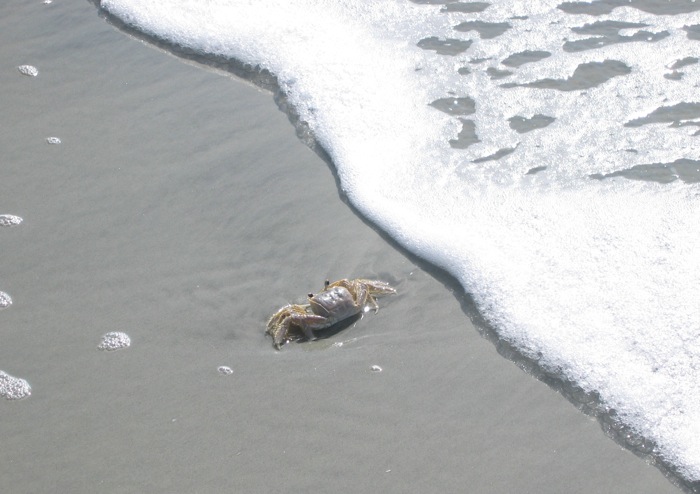 Here’s a ghost crab that doesn’t mind getting a soggy bottom. This one sprinted from the dunes to the surf, stopped abruptly, and sat a spell. (Photograph by Anthony Martin.)
Here’s a ghost crab that doesn’t mind getting a soggy bottom. This one sprinted from the dunes to the surf, stopped abruptly, and sat a spell. (Photograph by Anthony Martin.)
I took photos while walking toward this crab, expecting it to bolt at any moment. Instead, I was instead surprised to see it remain where it sat, even as its eye stalks rotated to look warily at me. Amazed, I grasped that this one must have been thirsty enough to risk being eaten or stomped. The photo you see shows just how close I got to it, and I was thrilled to see it in exactly the same position depicted by the traces Ruth and I had seen the month before.
Although scientists aren’t always right, if you practice good science, you sometimes hit the nail on the head. Or the crab on the sand. Or, well, never mind. Anyway, this ghost crab is making a trace just like the ones documented the month before and in the same place, and it is a direct result of the same behavior interpreted from just the traces and some knowledge of their physiology. It’s almost as if science has predictive power. Who’d have thought? (Photograph by Anthony Martin.)
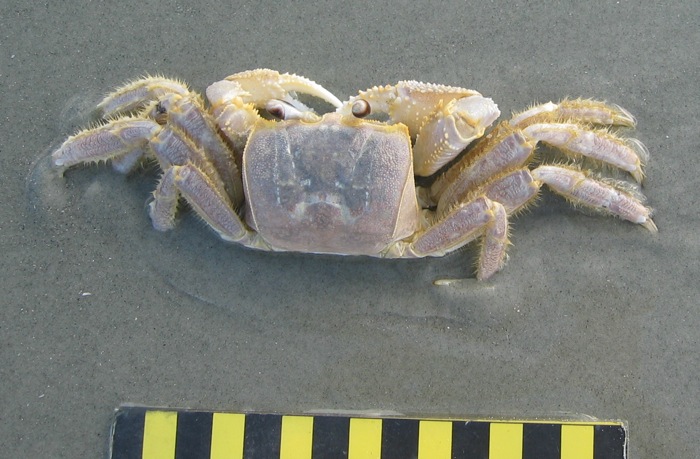 With the “resting trace = rehydration” hypothesis now supported by both traces and direct observation, I wrote the results into a formal, peer-reviewed paper. Unexpectedly, such traces had never been documented for ghost crabs, and especially from the perspective of a paleontologist. In the paper, published in 2006, I pointed out that this behavior would explain similar-looking trace fossils in the geologic record, or the preservation of crab bodies frozen in the same position by death, perhaps reaching the surf too late and being buried by wave-borne sands. The geological significance of such trace fossils would be their value in pointing exactly to where the surf may have washed across an ancient shore, millions of years ago. Geologists really like this kind of precision, and become grateful to ichnologists who give them such tools they can easily use in the field.
With the “resting trace = rehydration” hypothesis now supported by both traces and direct observation, I wrote the results into a formal, peer-reviewed paper. Unexpectedly, such traces had never been documented for ghost crabs, and especially from the perspective of a paleontologist. In the paper, published in 2006, I pointed out that this behavior would explain similar-looking trace fossils in the geologic record, or the preservation of crab bodies frozen in the same position by death, perhaps reaching the surf too late and being buried by wave-borne sands. The geological significance of such trace fossils would be their value in pointing exactly to where the surf may have washed across an ancient shore, millions of years ago. Geologists really like this kind of precision, and become grateful to ichnologists who give them such tools they can easily use in the field.
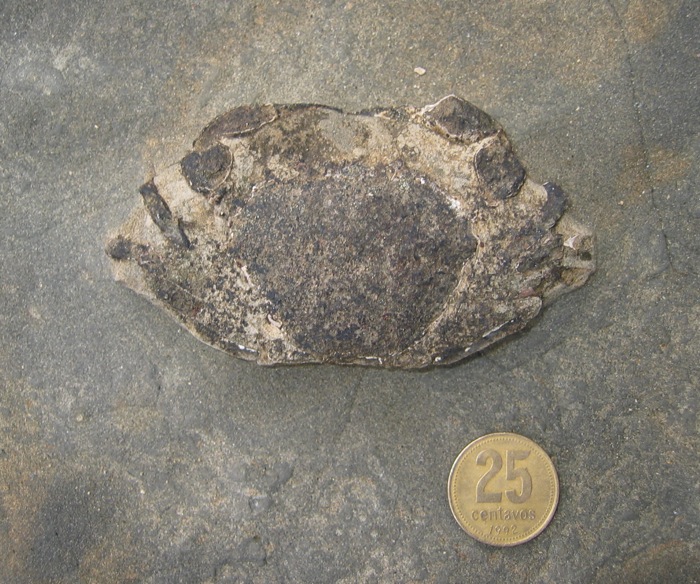 A fossil crab from the Miocene Epoch (about 15 million years old), preserved in a sandstone bed cropping out on a beach near Comodora Rivadavia, Argentina. This crab and others like it in the sandstone were all preserved the same way: nearly entire, implying they were buried quickly, and parallel to the original sandy surface on which they settled. Could these have died after dehydration near the surf, and then been buried? How long ago did some crabs evolve to become semi-terrestrial? I don’t know, but now we have a hypothesis that can be applied to fossils like these and tested. (Coin is about 2.5 cm (1 in) wide; Photograph by Anthony Martin.)
A fossil crab from the Miocene Epoch (about 15 million years old), preserved in a sandstone bed cropping out on a beach near Comodora Rivadavia, Argentina. This crab and others like it in the sandstone were all preserved the same way: nearly entire, implying they were buried quickly, and parallel to the original sandy surface on which they settled. Could these have died after dehydration near the surf, and then been buried? How long ago did some crabs evolve to become semi-terrestrial? I don’t know, but now we have a hypothesis that can be applied to fossils like these and tested. (Coin is about 2.5 cm (1 in) wide; Photograph by Anthony Martin.)
Since then, I have seen these resting traces on the beaches of every Georgia barrier island, in the Bahamas, and other places where ghost crabs dwell. Although trace fossils echoing this behavior in ghost crabs or their ancestors have not yet been found, I predict that with the right images now in mind, geologists and paleontologists will recognize them some day.
So with this ichnological lesson from ghost-crab traces, I hope they have become just a bit less “ghostly” and much more alive in your imaginations.
Further Reading
Duncan, G.A. 1986. Burrows of Ocypode quadrata (Fabricus) as related to slopes of substrate surfaces. Journal of Paleontology, 60: 384-389.
Martin, A.J. 2006. Resting traces of Ocypode quadrata associated with hydration and respiration: Sapelo Island, Georgia, USA. Ichnos, 13: 57-67.
Wolcott, T. G. 1978. Ecological role of ghost crabs, Ocypode quadrata (Fabricius) on an ocean beach: Scavengers or predators? Journal of Experimental Marine Biology and Ecology, 31: 67-82.
Wolcott, T. G. 1984. Uptake of interstitial water from soil: mechanisms and ecological significance in the ghost crab Ocypode quadrata and two gecarcinid land crabs. Physiological Zoology, 57: 161-184.
